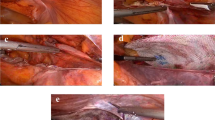Abstract
Incisional hernia remains a very common postoperative complication. These are encountered with an incidence of up to 20 % following laparotomy. These hernias enlarge over time, making the repair difficult, and serious complications like bowel obstruction, strangulation and enterocutaneous fistula can occur. Hence, elective repair is indicated to avoid these complications. Implantation of a prosthetic mesh is nowadays considered as the standard treatment due to low hernia recurrence. The most common mesh repair techniques used are the onlay repair, sublay repair and laparoscopic intraperitoneal onlay mesh (IPOM). However, it is still not clear which technique among the three is superior. A study consisting of 30 patients who underwent incisional hernia repair by onlay, laparoscopic and preperitoneal mesh repair with abdominoplasty was conducted in the Coimbatore Medical College and Hospital. Of the three groups, the preperitoneal repair with abdominoplasty was found to have better patient compliance and satisfaction with regard to occurrence of complications and appearance of the abdominal wall without laxity in a single sitting.

Similar content being viewed by others
References
Mudge M, Hughes LE (1985) Incisional hernia: a 10 year prospective study of incidence and attitudes. Br J Surg 72:70–71. doi:10.1002/bjs.1800720127
Read RC, Yoder G (1989) Recent trends in the management of incisional herniation. Arch Surg 124:485–488. doi:10.1001/archsurg.1989.01410040095022
Den Hartog D, Dur AH, Tuinebreijer WE, et al (2008) Open surgical procedures for incisional hernias. Cochrane Database Syst Rev (3):CD006438
de Vries Reilingh TS, van Geldere D, Langenhorst B, de Jong D et al (2004) Repair of large midline incisional hernias with polypropylene mesh comparison of three operative techniques. Hernia 8(1):56–59
Kurzer M, Kark A, Selouk S, Belsham P et al (2008) Open mesh repair of incisional hernia using a sublay technique: long-term follow-up. World J Surg 32(1):31–36
'Wéber G, Baracs J, Horváth OP, et al. Onlay mesh provides significantly better results than sublay reconstruction. Prospective randomized multicenter study of abdominal wall reconstruction with sutures only, or with surgical mesh—results of a five-year follow-up
Author information
Authors and Affiliations
Corresponding author
Rights and permissions
About this article
Cite this article
Natarajan, S., Meenaa, S. & Thimmaiah, K.A. A Randomised Prospective Study to Evaluate Preperitoneal Mesh Repair Versus Onlay Mesh Repair and Laparoscopic IPOM in Incisional Hernia Surgery. Indian J Surg 79, 96–100 (2017). https://doi.org/10.1007/s12262-015-1430-5
Received:
Accepted:
Published:
Issue Date:
DOI: https://doi.org/10.1007/s12262-015-1430-5




